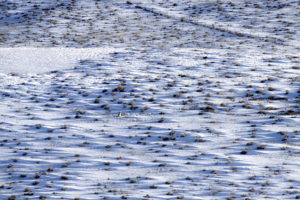It doesn’t happen as much as most of you wish, but on occasion you have a pair or more coyotes show up at your setup. Your heart begins racing, your entire body begins quivering and you mentally make a game plan on the fly as fur balls close the distance faster than Carl Lewis.
Sometimes your auto pilot kicks in and you shoot the first target that presents itself. Sometimes one shot suddenly becomes more difficult and you swing the reticle to a higher percentage hit. Sometimes a coyote disappears and you have to aim at the remaining scoundrel whether you like the shot, or not.
On a recent set I had spotted a single coyote loping in a parallel route that started to angle away. I found the coyote in my Nikon riflescope and followed it as it ascended a nearby hill. I was about to bark and stop the coyote instead of trying to lead it on the lope. As my mouth opened for the bark a second coyote appeared in my reticle. My intended target slowed and passed the coyote that slipped unnoticed to the scene. Since this coyote was sitting and watching I shifted the aim and lined up all of my reticles on the body to ensure a hit regardless of the distance. That coyote tipped over from an ELD-X bullet to the chest, but even my best distress calls and some legwork from my coyote dog couldn’t make the runner slow.
Did I make the right decision? Consider this furtakers’ take on the bird in the bush proverb: A coyote in the truck is worth more than two bounding in the sagebrush.
Everyone has their own reasoning when it comes to which one to shoot first and the answer often arrives in a split second. Nevertheless, if you do have a chance to think a situation through you may be plagued with even more questions that slow your decision-making process. Here are a few examples to ponder.
Split Ends
A common behavior, particularly in late winter and early spring, is for a pair to arrive and then split as they survey the scene. It’s even common for one coyote to stop further out as the other advances. With one coyote closing the distance and a second coyote sitting perfectly at long range which one do you shoot first?
Common sense tells you that you should always take the easiest shot first, but with the technological advancements in rifles, firearms and ammunition maybe you should take the easy long shot and then attempt to stop the closer coyote for a standing, chip shot? If you’re utilizing a suppressor that first shot may not even make the closer coyote flinch. Even if the closer coyote won’t stop, your running shot will be closer than the running shot of the farther coyote on over-watch duty.
Makes you think, doesn’t it?
A Urinary Track
Here’s a quandary you could run into tomorrow. Say you’re watching a pair approach your stand site and they both stop to mark territory. The one on the left lifts its leg in manliness while the right coyote squats to reveal its female nature. As you situate for the shot do you target the male or the female first? Whoa! Before you pull that trigger you now have the male racing way ahead of the female and about to give you a textbook shot. Do you shoot the easy male first or the risker shot on the female?
Consider this fact before shooting. It’s something I’ve seen and other seasoned coyote hunters have experienced too. The male often looks for the female if she is dropped first. He’s focused on love and doesn’t want his date to slip away. On one set this winter I had a pair show up and couldn’t tell the sex of the either coyote. That’s the norm. It didn’t matter to me so I swung my Bergara rifle and shot the closest coyote first.
Despite distress yips and barks I couldn’t get the second coyote to stop and it disappeared over a ridge only yards behind it. When I went to collect the other coyote I discovered it was a male. Since it was February and breeding was in full swing I assumed the second coyote was a female. If my guess was right and I had seen a clue that the other coyote was a female I may have changed my tactic. And then again …?
You don’t often get much time to think when a pair of coyote blazes into your setup, but if you do, make sure you make the best decision for a surefire fur payout.







